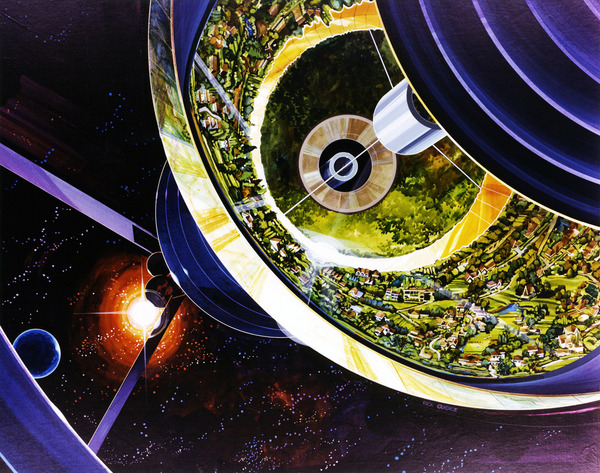This article explores: The environmental impact of Bernal Spheres on outer space and the Earth. Find out more about the Environmental Impact of Bernal Spheres.
As humanity continues to explore the frontiers of space, the concept of space habitats, such as Bernal Spheres, has gained renewed interest.

These massive structures, which could potentially house thousands of people in self-contained environments, offer a tantalizing vision of a future where humanity has expanded beyond the boundaries of Earth.
However, the construction and operation of Bernal Spheres also raise important questions about their potential environmental impact, both in outer space and on Earth.
In this essay, we will explore the potential environmental impact of Bernal Spheres on both the space environment and the Earth, and consider the steps that could be taken to mitigate any negative effects.
How Large Will A Bernal Sphere Be?
A Bernal Sphere is a hypothetical space habitat designed by physicist John Desmond Bernal. The size of a Bernal Sphere would depend on its intended use and the number of people it would accommodate.
In one of Bernal’s designs, the sphere had a diameter of 16 kilometers (about 10 miles), which would be large enough to house a population of up to 10,000 people.
However, other designs have suggested smaller or larger sizes depending on the requirements.
The sphere would have a rotational axis perpendicular to the plane of the equator, and it would rotate to create an artificial gravity through centrifugal force.
The interior of the sphere would be divided into habitable levels, with living areas, agricultural sections, and industrial areas.
Overall, the size of a Bernal Sphere would depend on the specific requirements of the project, but it is likely to be quite large, possibly in the range of several kilometers in diameter.
How Much Material Will Be Required To Build A Bernal Sphere?
The amount of material required to build a Bernal Sphere would depend on several factors, including the size of the sphere, the thickness of its walls, and the materials used in its construction.
Assuming a Bernal Sphere with a diameter of 16 kilometers (10 miles) and a wall thickness of 1 meter, the volume of material required to build the sphere would be approximately 4.19 x 10^12 cubic meters. This calculation assumes that the sphere is a solid shell and does not take into account any internal structure.
The exact composition of the material used in construction would also affect the amount required. For example, if the sphere were constructed using a lightweight material like carbon fiber, less material would be required compared to a sphere made of heavier materials like steel.
Additionally, the construction process would likely involve launching materials into space and assembling them in orbit. This would add to the overall cost and complexity of the project.
Overall, building a Bernal Sphere would require a significant amount of resources and would be a challenging engineering feat.
What Will Be The Environmental Impact In Space Of Constructing A Bernal Sphere?
Constructing a Bernal Sphere would take place entirely outside of Earth’s atmosphere. So it could have some indirect environmental impacts in space.
One potential impact could be the generation of space debris. The construction process would likely involve launching materials and equipment into space, and any discarded or unused materials could become debris that could pose a risk to other spacecraft and satellites in orbit.
To mitigate this risk, it would be necessary to carefully plan and execute the construction process, taking into account orbital mechanics and ensuring that all materials are properly secured or deorbited at the end of the project.
Another potential impact could be the disruption of local environments. The Bernal Sphere would likely be built in a stable orbit around a planet or moon, and its construction could potentially disturb the natural balance of objects in that orbit.
This could be especially important if the object has its own natural satellites or other objects in its vicinity.
Finally, the operation of the Bernal Sphere could have environmental impacts, such as the generation of waste heat and electromagnetic radiation.
These impacts would need to be carefully considered and mitigated to ensure that they do not cause harm to other spacecraft or to any nearby celestial bodies.
Overall, the construction of a Bernal Sphere would need to be carefully planned and executed to minimize any potential environmental impacts in space.
What Will Be The Environmental Impact On Earth Of Constructing A Bernal Sphere?
The construction of a Bernal Sphere in space would not have any direct environmental impact on Earth, as it would be carried out entirely in space.
However, there could be indirect environmental impacts associated with the resources required to build and operate the sphere.
For example, the construction and operation of a Bernal Sphere would require significant amounts of energy, which could be generated using fossil fuels or other non-renewable resources. This could contribute to climate change and other environmental problems on Earth.
Additionally, the construction and operation of the Bernal Sphere would require a significant amount of resources, including metals, plastics, and other materials.
The extraction, production, and transportation of these materials could have environmental impacts, such as habitat destruction, pollution, and greenhouse gas emissions.
Finally, the construction of a Bernal Sphere could divert resources and attention away from environmental issues on Earth.
Given the urgent need to address climate change and other environmental challenges facing our planet, some might argue that resources would be better spent addressing these issues directly rather than building large-scale space habitats.
Overall, while the construction of a Bernal Sphere would not have direct environmental impacts on Earth, it could contribute to a range of environmental challenges through the resources required for its construction and operation.
References for : “The environmental impact of Bernal Spheres on outer space and the Earth”
Here are some references related to the environmental impact of Bernal Spheres on outer space and the Earth:
“Space Habitats and the Environment: Building a Low-Impact Future in Space” by Al Globus, published in the journal New Space in 2017.
“Environmental Considerations for Large Space Habitats” by John D. Moore and E. Jeffrey Lupisella, published in the journal Acta Astronautica in 2000.
“Ecological Sustainability of Space Habitats” by O. Yehuda and H. Sagit, published in the journal Advances in Space Research in 2012.
“Sustainable Space Settlements: A Planetary and Space Habitat Perspective” by David Raitt, published in the journal Sustainability in 2016.
“Bernal Sphere” on the website of the National Space Society, which includes information on the environmental considerations of Bernal Spheres.
These references offer insights into the potential environmental impacts of Bernal Spheres and the steps that can be taken to ensure their construction and operation are sustainable and environmentally responsible.
‘Building Bernal Spheres’ is one important topic in our series exploring the role of Bernal Spheres in space colonization.
Read more about these topics by following the links below:
Republished by Blog Post Promoter
